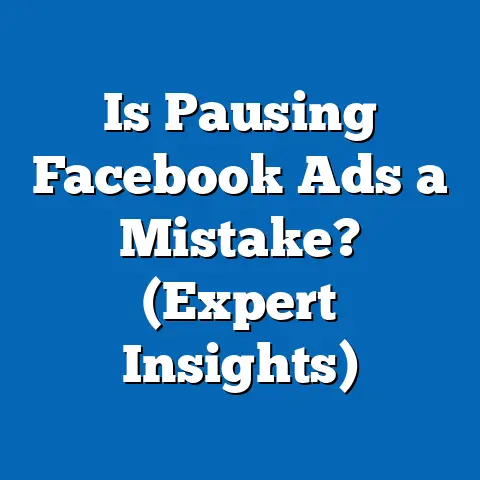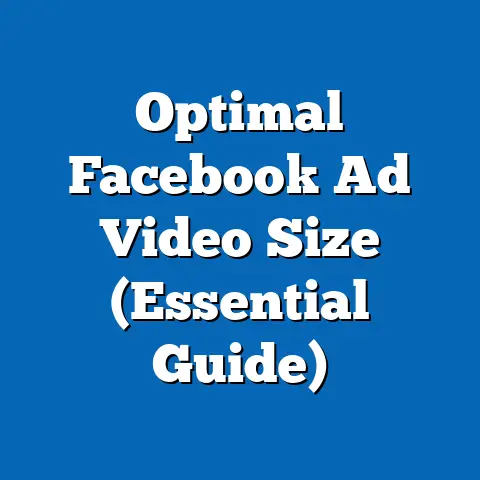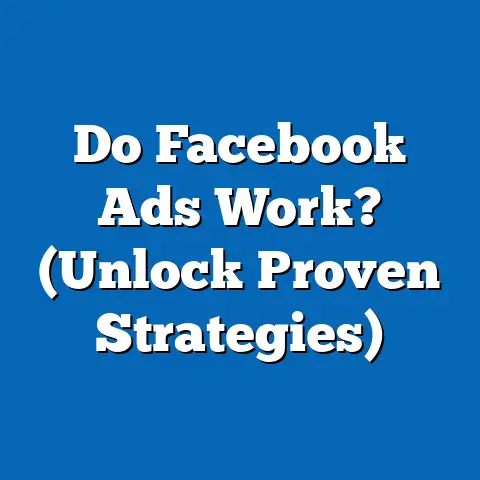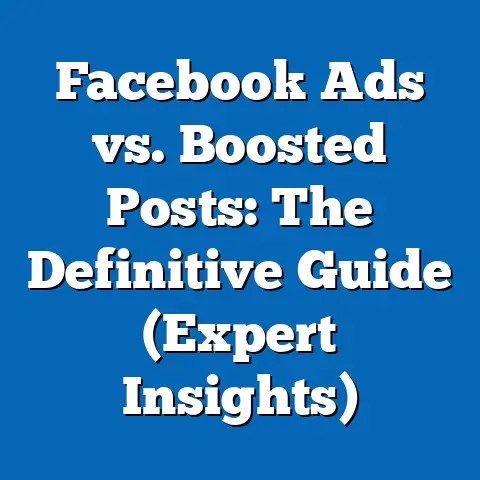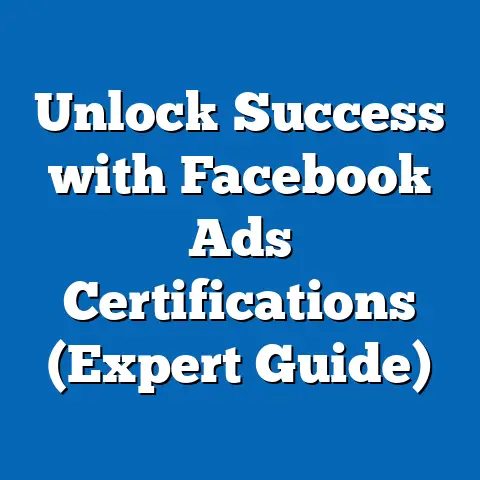Buy Political Ads on Facebook (Essential Guide for Marketers)
The political landscape is constantly evolving, and in today’s digital age, social media plays a pivotal role in shaping public opinion and influencing electoral outcomes. Among the various social media platforms, Facebook stands out as a powerful tool for political campaigns due to its massive user base, sophisticated targeting capabilities, and versatile advertising options. I’ve seen firsthand how a well-crafted Facebook ad campaign can significantly impact voter engagement and drive positive results for political candidates.
What truly sets Facebook apart is its accessibility. Whether you’re a seasoned political strategist or a newcomer to the world of digital advertising, Facebook’s advertising platform is designed to be user-friendly and intuitive. Its unique features, such as granular targeting, real-time analytics, and flexible budgeting, make it an ideal choice for political marketers looking to maximize their reach and impact.
Understanding Facebook’s Advertising Landscape
Facebook’s advertising ecosystem is a dynamic and complex environment that offers a unique set of opportunities and challenges for political marketers. Unlike traditional advertising channels, such as television or print, Facebook allows you to reach a highly targeted audience with personalized messages, making it an incredibly powerful tool for influencing voter behavior.
One of the key differences between Facebook advertising and traditional advertising is the level of engagement it allows. On Facebook, users can interact with your ads by liking, commenting, sharing, and even clicking through to your website or campaign page. This level of interaction provides valuable feedback on your messaging and allows you to build relationships with potential voters in a way that traditional advertising simply can’t.
Facebook offers a variety of ad formats that can be used effectively in political campaigns. These include:
- Image Ads: Simple yet effective, image ads are great for showcasing your candidate’s message with a visually appealing image or graphic.
- Video Ads: Video ads are highly engaging and can be used to tell your candidate’s story, highlight their policy positions, or share testimonials from supporters.
- Carousel Ads: Carousel ads allow you to showcase multiple images or videos in a single ad, making them ideal for highlighting different aspects of your candidate’s platform or campaign.
- Instant Experience Ads: These full-screen ads provide an immersive experience for users, allowing them to explore your candidate’s message in an interactive and engaging way.
The benefits of using Facebook ads for political messaging are numerous. First and foremost, Facebook allows you to reach a diverse audience, including potential voters who may not be reachable through traditional advertising channels. Additionally, Facebook’s targeting capabilities allow you to reach specific groups of voters based on demographics, interests, and behaviors, ensuring that your message is seen by the people who are most likely to be influenced by it.
Another key benefit of Facebook advertising is its ability to engage potential voters in a meaningful way. By creating ads that are relevant, informative, and engaging, you can spark conversations, build relationships, and ultimately persuade voters to support your candidate. I’ve found that ads that ask questions or prompt users to share their opinions tend to generate the most engagement and can be a great way to start a dialogue with potential voters.
Takeaway: Facebook advertising offers a unique and powerful way to reach and engage potential voters, thanks to its diverse ad formats, granular targeting capabilities, and interactive nature.
Navigating the Ad Creation Process
Creating a political ad on Facebook may seem daunting at first, but with a step-by-step approach and a little bit of practice, it can become a straightforward and rewarding process. I’ve guided numerous political campaigns through this process, and I’ve found that breaking it down into manageable steps is the key to success.
Here’s a breakdown of the ad creation process:
- Setting Up a Business Manager Account: The first step is to create a Business Manager account on Facebook. This account will serve as the central hub for managing your ad campaigns, ad accounts, and Facebook Pages. If you don’t already have a Business Manager account, you can create one for free on Facebook’s website.
- Creating an Ad Account: Once you have a Business Manager account, you’ll need to create an ad account. This is where you’ll set your budget, choose your targeting options, and create your ads. To create an ad account, simply navigate to the “Ad Accounts” section of your Business Manager and follow the prompts.
-
Choosing the Right Ad Objective: Facebook offers a variety of ad objectives, each designed to achieve a specific goal. For political campaigns, some of the most relevant ad objectives include:
- Engagement: This objective is designed to increase likes, comments, and shares on your ads and Facebook Page.
- Traffic: This objective is designed to drive traffic to your website or campaign page.
- Reach: This objective is designed to show your ad to the maximum number of people within your target audience.
- Conversions: This objective is designed to drive specific actions on your website, such as signing up for your email list or donating to your campaign.
- Crafting Compelling Ad Copy and Selecting Eye-Catching Visuals: The ad copy and visuals are the heart of your Facebook ad. Your ad copy should be clear, concise, and persuasive, highlighting your candidate’s key policy positions and appealing to the emotions of your target audience. Your visuals should be eye-catching and relevant to your message, capturing the attention of users as they scroll through their newsfeeds.
- A/B Testing Different Ad Variations: A/B testing involves creating multiple versions of your ad with slight variations in the ad copy, visuals, or targeting options. By running these ads simultaneously and tracking their performance, you can identify which variations are most effective and optimize your campaign accordingly. I always recommend testing at least two different versions of your ad to see what resonates best with your audience.
Choosing the Right Ad Objective: Facebook offers a variety of ad objectives, each designed to achieve a specific goal. For political campaigns, some of the most relevant ad objectives include:
- Engagement: This objective is designed to increase likes, comments, and shares on your ads and Facebook Page.
- Traffic: This objective is designed to drive traffic to your website or campaign page.
- Reach: This objective is designed to show your ad to the maximum number of people within your target audience.
- Conversions: This objective is designed to drive specific actions on your website, such as signing up for your email list or donating to your campaign.
- Crafting Compelling Ad Copy and Selecting Eye-Catching Visuals: The ad copy and visuals are the heart of your Facebook ad. Your ad copy should be clear, concise, and persuasive, highlighting your candidate’s key policy positions and appealing to the emotions of your target audience. Your visuals should be eye-catching and relevant to your message, capturing the attention of users as they scroll through their newsfeeds.
- A/B Testing Different Ad Variations: A/B testing involves creating multiple versions of your ad with slight variations in the ad copy, visuals, or targeting options. By running these ads simultaneously and tracking their performance, you can identify which variations are most effective and optimize your campaign accordingly. I always recommend testing at least two different versions of your ad to see what resonates best with your audience.
Here are some tips on best practices for ad design and messaging that resonates with political audiences:
- Keep it Simple: Avoid using jargon or complex language that may confuse or alienate voters.
- Focus on Benefits: Highlight the benefits that your candidate will bring to the community if elected.
- Use Strong Visuals: Choose images and videos that are visually appealing and relevant to your message.
- Include a Clear Call to Action: Tell voters exactly what you want them to do, whether it’s visiting your website, signing up for your email list, or donating to your campaign.
- Be Authentic: Let your candidate’s personality shine through in your ads. Voters are more likely to support candidates who they perceive as genuine and relatable.
Takeaway: Creating effective political ads on Facebook involves a step-by-step process, from setting up your Business Manager account to crafting compelling ad copy and visuals. A/B testing is crucial for optimizing your campaign’s performance.
Targeting Your Audience Effectively
One of the most powerful features of Facebook advertising is its ability to target specific audiences based on a wide range of criteria. This allows you to reach potential voters who are most likely to be interested in your candidate’s message, maximizing the impact of your ad spend. I’ve seen campaigns drastically improve their ROI by focusing on highly targeted audiences.
Facebook offers a variety of targeting options, including:
- Demographic Targeting: This allows you to target voters based on their age, gender, location, education, and other demographic factors.
- Interest Targeting: This allows you to target voters based on their interests, hobbies, and activities on Facebook.
- Behavior Targeting: This allows you to target voters based on their past behavior on Facebook, such as the pages they’ve liked, the ads they’ve clicked on, and the events they’ve attended.
- Custom Audiences: This allows you to upload your own list of voters (e.g., email addresses, phone numbers) and target them directly on Facebook.
- Lookalike Audiences: This allows you to create audiences that are similar to your existing customers or voters, expanding your reach to potential supporters who share similar characteristics.
To create a voter profile and leverage Facebook’s targeting tools effectively, consider the following steps:
- Identify Your Target Audience: Start by identifying the specific groups of voters that you want to reach. This may include swing voters, young voters, senior citizens, or voters who are passionate about a particular issue.
- Research Their Demographics, Interests, and Behaviors: Once you’ve identified your target audience, research their demographics, interests, and behaviors on Facebook. What are their ages, genders, and locations? What pages do they like? What events do they attend?
- Use Facebook’s Targeting Tools to Reach Them: Use the information you’ve gathered to create targeted audiences on Facebook. Experiment with different targeting options to see which combinations are most effective.
- Utilize Lookalike Audiences: Once you’ve built a custom audience of existing supporters, use Facebook’s Lookalike Audiences feature to expand your reach to potential voters who share similar characteristics.
Here are some tips on utilizing Facebook’s Lookalike Audiences feature to expand reach and engage similar potential voters:
- Start with a High-Quality Seed Audience: The quality of your Lookalike Audience depends on the quality of your seed audience. Make sure your seed audience is made up of your most engaged and valuable supporters.
- Experiment with Different Similarity Percentages: Facebook allows you to create Lookalike Audiences that are between 1% and 10% similar to your seed audience. Experiment with different similarity percentages to see which ones perform best.
- Test Different Targeting Options: Even when using Lookalike Audiences, it’s important to test different targeting options to see which combinations are most effective.
Takeaway: Effective audience targeting is crucial for maximizing the impact of your Facebook ad campaigns. By leveraging Facebook’s demographic, interest, behavior, custom, and Lookalike Audience targeting options, you can reach the voters who are most likely to be influenced by your message.
Budgeting and Bidding Strategies
Setting the right budget and choosing the right bidding strategy are essential for maximizing your return on investment (ROI) on Facebook advertising. I’ve seen campaigns waste significant amounts of money by not carefully considering their budget and bidding options.
Facebook offers two main budgeting options:
- Daily Budgets: With daily budgets, you set a fixed amount that you’re willing to spend on your ads each day. This is a good option if you want to control your spending on a daily basis.
- Lifetime Budgets: With lifetime budgets, you set a fixed amount that you’re willing to spend on your ads over the entire duration of your campaign. This is a good option if you want to control your overall spending and let Facebook optimize your budget over time.
When choosing between daily and lifetime budgets, consider the following factors:
- Your Campaign Duration: If your campaign is short-term, a daily budget may be more appropriate. If your campaign is long-term, a lifetime budget may be a better option.
- Your Level of Involvement: If you want to be actively involved in managing your budget on a daily basis, a daily budget may be a better choice. If you prefer to let Facebook optimize your budget over time, a lifetime budget may be more suitable.
Facebook also offers two main bidding strategies:
- Manual Bidding: With manual bidding, you set the maximum amount that you’re willing to pay for each click or impression on your ads. This gives you more control over your bidding, but it also requires more monitoring and optimization.
- Automatic Bidding: With automatic bidding, Facebook automatically sets your bids based on your campaign objectives and target audience. This is a good option if you want to let Facebook optimize your bidding for you.
When choosing between manual and automatic bidding, consider the following factors:
- Your Level of Expertise: If you’re experienced with Facebook advertising and comfortable managing your bids, manual bidding may be a good choice. If you’re new to Facebook advertising, automatic bidding may be a better option.
- Your Campaign Objectives: If you have specific ROI goals, manual bidding may be necessary to achieve them. If your primary goal is to reach as many people as possible, automatic bidding may be more suitable.
Here are some insights on monitoring ad spend and making adjustments to optimize campaign performance:
- Track Your Key Metrics: Regularly monitor your key metrics, such as reach, engagement, conversions, and cost per result.
- Identify Underperforming Ads: Identify ads that are not performing well and make adjustments to improve their performance. This may involve changing the ad copy, visuals, or targeting options.
- Increase Bids on High-Performing Ads: If you have ads that are performing well, consider increasing your bids to reach more people.
- Pause or Delete Underperforming Ads: If you have ads that are consistently underperforming, consider pausing or deleting them to avoid wasting your budget.
Takeaway: Choosing the right budgeting and bidding strategies is critical for maximizing your ROI on Facebook advertising. Consider your campaign duration, level of expertise, and campaign objectives when making these decisions.
Monitoring and Analyzing Ad Performance
Monitoring and analyzing your ad performance is crucial for understanding what’s working and what’s not, allowing you to make informed decisions about how to optimize your campaigns. I’ve seen campaigns turn around simply by paying closer attention to their data and making necessary adjustments.
Facebook Ads Manager provides a wealth of tools for tracking ad performance, including:
- Real-Time Reporting: Ads Manager provides real-time reporting on your key metrics, allowing you to see how your ads are performing at any given moment.
- Customizable Dashboards: You can create customizable dashboards to track the metrics that are most important to you.
- Automated Reports: You can schedule automated reports to be sent to your email inbox on a regular basis.
Key metrics to monitor include:
- Reach: The number of people who have seen your ads.
- Impressions: The number of times your ads have been displayed.
- Engagement: The number of likes, comments, and shares on your ads.
- Clicks: The number of times people have clicked on your ads.
- Conversions: The number of people who have taken a desired action on your website after clicking on your ads.
- Cost Per Result: The average cost you’re paying for each desired result (e.g., click, conversion).
Here’s how these metrics impact campaign success:
- High Reach and Impressions: These metrics indicate that your ads are being seen by a large number of people. However, if your engagement and conversion rates are low, it may indicate that your targeting is not effective.
- High Engagement: This metric indicates that your ads are resonating with your target audience.
- High Clicks and Conversions: These metrics indicate that your ads are driving desired actions on your website.
- Low Cost Per Result: This metric indicates that you’re getting a good return on your investment.
Analyzing data to refine advertising strategies and improve future campaigns involves:
- Identifying Trends: Look for trends in your data to identify what’s working and what’s not.
- Experimenting with Different Variables: Experiment with different ad copy, visuals, and targeting options to see what performs best.
- Making Data-Driven Decisions: Use your data to make informed decisions about how to optimize your campaigns.
Takeaway: Monitoring and analyzing your ad performance is essential for understanding what’s working and what’s not. Use Facebook Ads Manager to track your key metrics and make data-driven decisions about how to optimize your campaigns.
Navigating Compliance and Regulations
Political advertising on Facebook is subject to a number of legal considerations and regulations, including:
- Transparency Requirements: Facebook requires political advertisers to disclose the identity of the sponsor of their ads.
- Disclaimer Requirements: Political ads must include a disclaimer that identifies the sponsor of the ad and states that the ad was paid for.
- Content Restrictions: Facebook prohibits certain types of content in political ads, such as false or misleading information.
Transparency is crucial in political advertising on Facebook. You must clearly identify yourself as the sponsor of your ads and provide accurate information about your campaign. Failing to do so can result in your ads being disapproved or your account being suspended.
Here are some resources available for staying updated on compliance issues:
- Facebook’s Advertising Policies: Facebook’s advertising policies provide detailed information about the types of content that are allowed and prohibited on the platform.
- The Federal Election Commission (FEC): The FEC is the regulatory agency responsible for enforcing campaign finance laws in the United States.
- Your State’s Election Agency: Your state’s election agency can provide information about state-specific regulations related to political advertising.
Takeaway: Political advertising on Facebook is subject to a number of legal considerations and regulations. It’s important to understand these requirements and comply with them to avoid any legal issues.
Conclusion
Facebook advertising offers a powerful and accessible way for political campaigns to reach and engage potential voters. Its unique targeting capabilities, versatile ad formats, and real-time analytics make it an ideal choice for political marketers looking to maximize their reach and impact. I’ve seen firsthand how a well-executed Facebook ad campaign can significantly influence voter behavior and drive positive results for political candidates.
By following the steps outlined in this guide, you can create effective and impactful Facebook ad campaigns that resonate with your target audience and help achieve your political objectives. Whether you’re a seasoned political strategist or a newcomer to the world of digital advertising, Facebook’s advertising platform is designed to be user-friendly and intuitive.
Now, I encourage you to start exploring Facebook’s advertising options for your political campaigns. With a little bit of practice and a data-driven approach, you can leverage the power of Facebook advertising to connect with voters, build relationships, and ultimately win elections.

